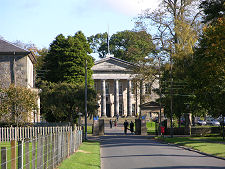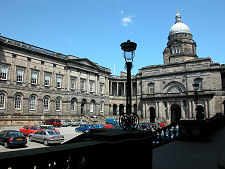 National Gallery of Scotland |
William Henry Playfair lived from 15 July 1790 to 19 March 1857. He was one of the most influential Scottish architects of the 1800s and played a leading role in shaping the Edinburgh we see today. The wider picture in Scotland at the time is set out in our Historical Timeline.
William Henry Playfair was born in London. His father was the Scottish architect James Playfair, and as a boy he moved to Edinburgh to live with his uncle, the scientist and mathematician, Professor John Playfair. Another of his uncles was the engineer and inventor of statistical graphics, William Playfair.
After qualifying as an architect in Edinburgh, Playfair rapidly built a successful practice. In 1817 he won a competition to finished the work begun by Robert Adam designing the University of Edinburgh Old College, the resulting building emerging during the 1820s. In 1818 he was commissioned to design Dollar Academy in Clackmannanshire.
But Playfair really came to prominence when he was commissioned in 1820 to design Regent Terrace, Royal Terrace and Calton Terrace in Edinburgh's New Town. Over the following thirty years he played an important part in designing many of the buildings that make Edinburgh the city it is today. These included the City Observatory on Calton Hill; the Royal Institution; the Monuments to Professor John Playfair (his uncle) and Dugald Stewart on Calton Hill; George Heriot's Hospital; the Advocates' Library; the Royal College of Surgeons; 105 George Street; Donaldson's Hospital; St Stephen's Church; Bonaly Tower; Free High Church and Free Church College; Royal Scottish Academy Building; New College, Edinburgh; and the National Gallery of Scotland, which was completed in 1850, two years after his death.
Perhaps the oddest of Playfair's structures on top of Calton Hill is the National Monument. Edinburgh had long been referred to as "The Athens of the North", usually ironically. To commemorate the fallen of the Napoleonic Wars it was decided to make Edinburgh's resemblance to Athens a literal one by building a replica of the Parthenon here. Work began in 1826 and ended when the money ran out in 1829, leaving the facade you see today. Some suggest that this was all that was intended, but it seems more likely that the original aspiration had been for a complete replica, including catacombs and a church in the form of a temple.
Playfair did not confine himself only to Edinburgh. Elsewhere, his major works include Floors Castle; Dunphail House in Morayshire; Lurgan House in Northern Ireland; and Spottiswoode House in Berwickshire.
He died on 19 March 1857 and was buried in Dean Cemetery in Edinburgh. After his death, over 5,000 of his drawings were left to Edinburgh University.



